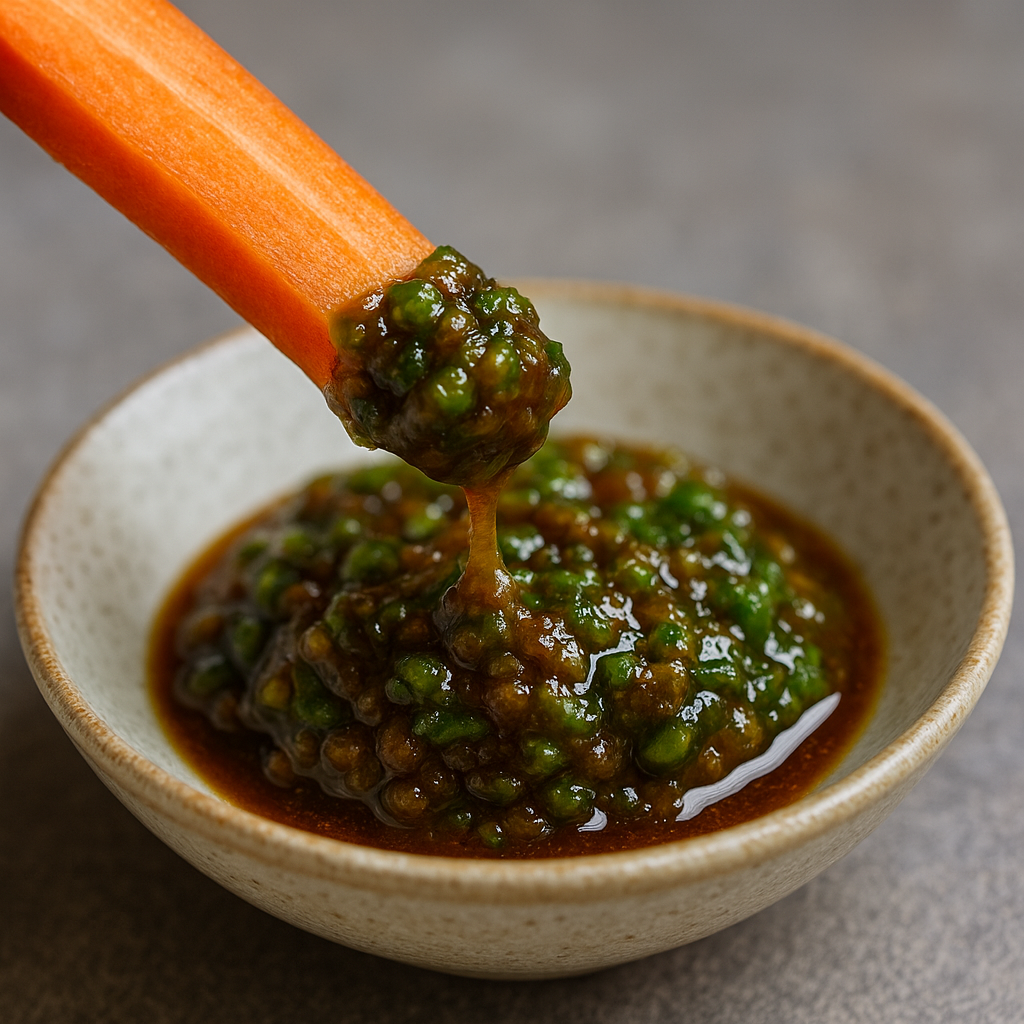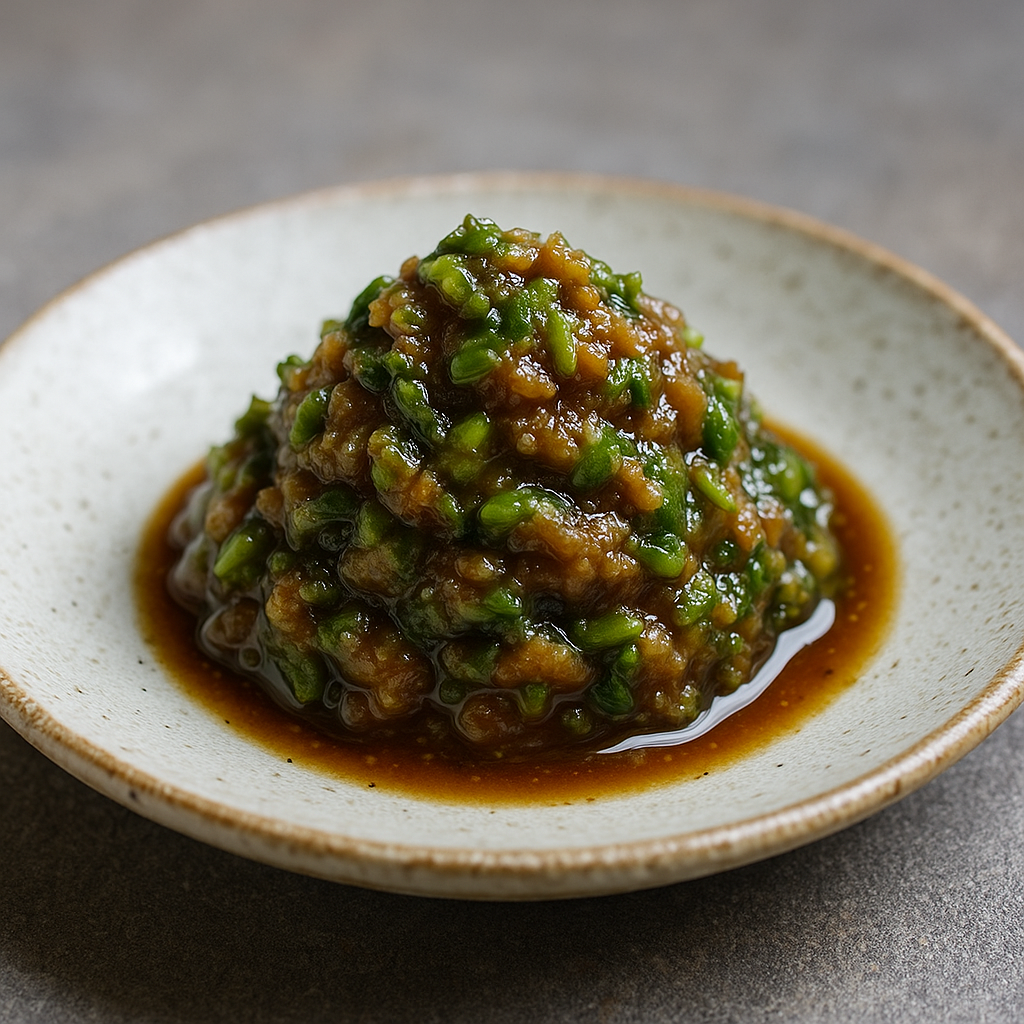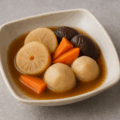
ばっけ味噌(秋田)の特徴
春の苦味と香りを味噌にとじ込めた常備菜
「ばっけ味噌」は、雪どけの頃に顔を出すふきのとう(秋田方言で“ばっけ”)を刻み、砂糖やみりんと合わせた味噌で練り上げる一品です。ほろ苦さとみその甘じょっぱさが調和し、ごはんや焼きおにぎり、田楽にもよく合います。
短時間の下茹ででアクを抜き、香りを生かす
ふきのとうはさっと茹でて冷水に取り、余分なアクだけを抜きます。油で軽く炒めてから調味していくことで、香りが立ち、口当たりもなめらかに仕上がります。
ばっけ味噌(秋田) レシピ
材料(作りやすい分量/約8〜10人分の目安)
- ふきのとう(ばっけ) … 150g
- 米味噌 … 80g
- 砂糖 … 大さじ2
- みりん … 大さじ2
- 酒 … 大さじ1
- 菜種油 … 大さじ1
- だし(または水) … 大さじ1〜2(硬さ調整)
- 薄口しょうゆ … 小さじ1/2(風味づけ)
- くるみ(粗く刻む) … 20g(お好みで)
作り方
- ふきのとうは外葉の傷みを除き、縦半分に割って流水で土を落とす。
- 塩少々を加えた熱湯で30〜60秒ゆで、すぐ冷水に取り、水気をしっかり絞る。
- 細かいみじん切りにする。
- 小ボウルで味噌・砂糖・みりん・酒を混ぜ、調味だれを作る。
- フライパンに油を熱し、ふきのとうを弱めの中火で炒め、香りを立たせる。
- 調味だれを加え、木べらで練り合わせながら水分を飛ばす。硬さが強ければだし(または水)で調整する。
- 薄口しょうゆで風味をととのえる。卵を加える場合は溶き卵を回し入れ、全体がしっとりするまで手早く混ぜる。くるみを加える場合は火を止める直前に合わせる。
- 清潔な保存容器に移し、粗熱を取ってから冷蔵する。
シェフのワンポイントアドバイス
- 下茹では短時間で止めると、香りを残しつつえぐみだけを和らげられます。
- 味噌を加えた後は弱火で“練る”ように加熱すると、艶と一体感が出ます。
- くるみを加えると香ばしさとコクが増します。
栄養価(1人分の目安/大さじ1)
- エネルギー … 約45〜60 kcal
- たんぱく質 … 約1.5〜2.0 g
- 脂質 … 約1.5〜3.0 g
- 炭水化物 … 約7〜9 g
- 食物繊維 … 約0.6〜1.0 g
- 食塩相当量 … 約0.8〜1.1 g
歴史
名称と由来
秋田ではふきのとうを「ばっけ」と呼び、その香りと苦味を生かす知恵として味噌と合わせた保存的な惣菜が発展しました。
春告げの山菜を日常へ
雪解けの山で採れるばっけを刻み、砂糖やみりんで調えた味噌と練り合わせることで、季節の恵みを日々の食卓に取り入れてきました。
現在の広がり
焼きおにぎりの塗り味噌、ふろふき大根や田楽のたれ、野菜スティックのディップなど使い道が広がり、土産用の瓶詰としても親しまれています。
English Version
Features of Bakke Miso (Akita)
A pantry condiment that captures spring’s bitterness and aroma
Bakke miso blends finely chopped fukinoto—spring butterbur buds called “bakke” in Akita—with sugar and mirin into a sweet-salty miso paste. The gentle bitterness harmonizes with umami-rich miso, pairing well with rice, grilled rice balls, and dengaku.
Brief blanching tames astringency while preserving fragrance
Fukinoto are quickly blanched and shocked in cold water to remove excess bitterness. A light sauté before seasoning lifts the aroma and yields a smooth, cohesive finish.
Recipe – Bakke Miso (Akita)
Ingredients (Makes about 8–10 servings)
- Fukinoto (butterbur buds; “bakke”) … 150 g
- Rice miso … 80 g
- Sugar … 2 tbsp
- Mirin … 2 tbsp
- Sake … 1 tbsp
- Canola oil … 1 tbsp
- Dashi (or water) … 1–2 tbsp (to adjust texture)
- Light soy sauce … 1/2 tsp (to finish)
- Walnuts, coarsely chopped … 20 g (optional)
- Egg … 1 (optional)
Directions
- Trim any damaged outer leaves. Halve each bud lengthwise and rinse well to remove grit.
- Blanch in salted boiling water for 30–60 seconds. Transfer to ice water, then squeeze thoroughly to remove excess moisture.
- Chop very finely.
- In a small bowl, mix miso, sugar, mirin, and sake to make the seasoning base.
- Heat oil over medium-low. Sauté chopped fukinoto gently until fragrant.
- Add the seasoning base. Stir and “knead” over low heat until moisture evaporates and the paste turns glossy; adjust firmness with a little dashi or water if needed.
- Finish with light soy sauce. If using the egg, drizzle in the beaten egg and stir quickly until just set and uniformly moist. Fold in walnuts right before turning off the heat.
- Transfer to a clean container. Let cool, then refrigerate.
Chef’s Tips
- Keep the blanch brief to mellow harshness while retaining the signature aroma.
- After adding miso, use low heat and a “stir-and-knead” motion for a shiny, unified paste.
- Walnuts add toasty depth; the optional egg softens edges and makes the paste mellower.
Nutrition (per tbsp ≈ 20 g, approx.)
- Energy … 45–60 kcal
- Protein … 1.5–2.0 g
- Fat … 1.5–3.0 g
- Carbohydrates … 7–9 g
- Dietary fiber … 0.6–1.0 g
- Salt equivalent … 0.8–1.1 g
History
Name and origin
In Akita, fukinoto are called “bakke.” Combining their fragrance and pleasant bitterness with miso evolved into a resourceful, keepable side dish.
From spring foraging to daily tables
Chopped bakke cooked with sweetened miso brought the fleeting taste of snowmelt season into everyday meals.
Contemporary uses
It now appears as a glaze for grilled rice balls, a sauce for simmered daikon and dengaku, and a dip for raw vegetables—also sold widely as jarred souvenirs.


何でも質問してください!